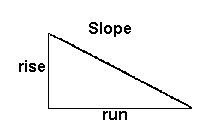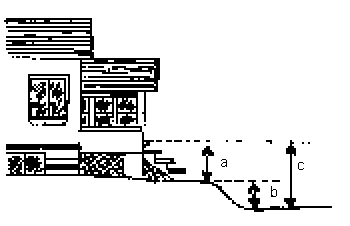

Ramps are built for people
who can't use stairs, or need a gentler, less stressful way to
change levels. A successful home rampbuilding project requires
careful planning, because compromises may have to be made among
many competing needs - of the person with a disability, other
household members, budget available, security concerns, appearance,
property market value. The following information should guide
you in this planning process.
 |
Slope: A ramp's slope - the angle of the inclined surfaces - is perhaps a project's most critical consideration, because of its impact on layout requirements, the expense involved, and the ramp's ultimate usefulness. Slope is the right-angle relationship of vertical height (rise) to horizontal length or projection (run). It is usually expressed as a ratio of these two measurements, with the rise figure frequently set at a unit of one. For example, a slope of 1:12 means that as each dimension unit of height changes, the other right-angle side projects out 12 units, which together result in a certain angle for the inclined, third side of the triangle. |

|
It's important to point out
that the larger the run figure in a slope ratio, the gentler
the angle for the
inclined surface will be - a 1:16 slope, for example, is not as
steep as a 1:12 slope. This fact is a source of initial confusion
for many people, who conceptualize that a bigger number must mean
a steeper slope. A comparative drawing (below) shows that it's
exactly the opposite situation. |
SAFETY ADVISORY:There may be a temptation to build a ramp that is steeper than the recommended 1 to 12 minimum in order to conserve space or reduce costs. Before deciding to build such a ramp, remember that the steeper the ramp is, the more dangerous it becomes to anyone using it. Ramp Project personnel have replaced steep ramps that have caused falls resulting in serious injuries and ramps that were so steep that the person needing it could not use it independently. |
The issue of how to choose
a slope for a residential ramp isn't clearly addressed in the
codes or handbooks, and is another source of confusion for many
people. Minnesota has a section in its building code - Chapter
1340 - that mandates the design for certain accessibility features
that must be installed in public/commercial settings. Chapter
1340 mandates slope ratios for ramps built for public/commercial
properties within the state, but single-family residences are
exempt from having to comply with these code requirements because
each ramp's design must be tailored for a particular person's
and home's circumstances.
For ramps in public/commercial settings, separate maximum slopes for exterior and interior ramps are actually set in the code. Interior and protected ramps may have slopes up to a 1:12, while exterior ramps (which in precise code language are referred to as "walks") must have gentler slope not exceeding 1:20. Because the code uses a 1:20 slope for exterior ramps, many people make the assumption that this is the only slope that can be used at houses as well. |
DO NOT BUILD RAMPS THAT ARE STEEPER THAN 1 TO 12Safety and independence are far more important than short-term savings or having a little less space. | In actuality, ramps for homes can be built at many different slopes and still be "right". For many households, the selection process requires balancing the desire for a very gentle slope with the amount of construction/cost involved, yard space that must be used, and appearance. The one general guideline that should be followed is that the slope should not exceed 1:12. Slopes steeper than this may be beyond the strength of many people using manual chairs, and may also cause an ascending electric wheelchair to tip backwards from a weight imbalance due to the low position in which the chair's battery pack is carried. They can also cause or aggravate back problems for helpers pushing a chair up a ramp, or controlling a chair traveling down one. |
The slope determination process
starts by first establishing how much total rise has to be covered.
Two measurements must be checked to determine this figure. The
first figure is the distance from the exit door's sill down to
the ground, or "grade", at the house's foundation. Since
a ramp is constructed a certain distance out from the house into
the yard, though, any change in grade in the area for the ramp's
construction also must be taken into account. For example, if
the change in grade from a home's doorsill to the ground at the
foundation is 29", and the yard out where the ramp will be
sited is flat-no change in grade-then the total rise that must
be covered is 29". However, if the change in grade at another
house's foundation is 29" (a), but the yard where the ramp
will be located drops away another 13" (b), then the total
rise that must be covered is 42" (c). (See below)

|
Once total rise (typically
stated in inches) is determined, it is then multiplied by the
slope (in inches) chosen, to obtain the total amount of horizontal
projection (in inches) required to achieve the particular slope.
Dividing this figure by 12 converts it into a more workable measurement
of feet of horizontal projection required. For example, say that
a ramp with a 1:12 slope is to be built at the home with a 29"
total rise described above. The required horizontal projection
is 29" X 12" = 348", or when converted to feet,
29'. Say, however, that a ramp with a gentler slope-a 1:16-is
desired. 29" of total rise X 16" of slope = 464",
and when divided by 12 to convert to feet, equals over 38 feet
of horizontal projection needed.
It's important to note that
the resulting figure is a measurement of amount of horizontal
projection the layout must contain to achieve a desired slope.
It is not a measurement of distance traveled along the inclined
surface, as some people mistakenly believe, and it doesn't
include any distances/areas required for necessary landings-these
are extra. |
To compute Slope Ratio
Each inch of height requires a certain number of inches in distance to provide a slope. Multiply inches of rise (29" as an example) by the ratio you want, getting inches first and then dividing by 12 to convert to feet.
1 to 20 1 to 12
20 rise 12
x29 length x29
______ (inches) _____
580 348
divide by 12
(to convert to feet)
48'4" 29'
LENGTH OF SLOPE IN FEET
|